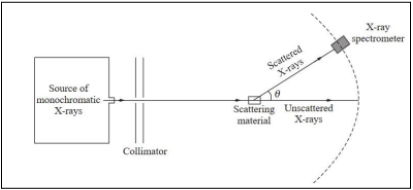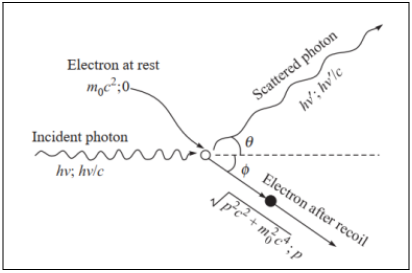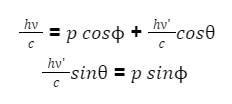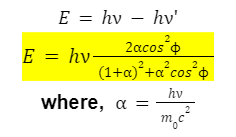
The Compton Effect was discovered by A.H. Compton in 1923, it is the scattering of high-frequency photons after an interaction with a charged particle called electron, it results in a decrease in energy and an increase in wavelength of a photon which may be X-Ray or Gamma Ray photon.
“When a monochromatic beam of X-Rays is scattered by an element of low atomic weight (for example carbon), it is observed that the scattered X-Rays at all angles have maximum intensities at two wavelengths one at the original wavelength and other at a slightly longer wavelength. The wavelength shift is independent of the wavelength of the incident beam and the scattering material, it depends only on the scattering angle. This phenomenon is called the Compton Effect”.
 Compton explains this phenomenon using the Quantum theory of radiation. He considered X-ray as a stream of photons,
Compton explains this phenomenon using the Quantum theory of radiation. He considered X-ray as a stream of photons,
hv = Energy of each Photon.
Hv/c = Momentum of each photon.
v = frequency of incident photon h = Planck’s constantc = the speed of light.
Compton Scattering is considered as an elastic collision between a photon and a free electron which is initially at rest. In the collision, a part of photon energy is transferred to an electron which recoils. The scattered photon has a smaller energy and hence a lower frequency. v' = The frequency of scattered photons.
m
0
= Rest mass of an electron.
p = Recoil momentum of an electron.
= Angle of the scattered photon.
= Angle of recoil electron.
According to the theory of relativity, the energy of an electron at rest is m
0
c
2
and after recoil is
v' = The frequency of scattered photons.
m
0
= Rest mass of an electron.
p = Recoil momentum of an electron.
= Angle of the scattered photon.
= Angle of recoil electron.
According to the theory of relativity, the energy of an electron at rest is m
0
c
2
and after recoil is
 From the law of conservation of energy,
From the law of conservation of energy,
Energy before collision = Energy after collision

The kinetic energy of Recoil electron:


















